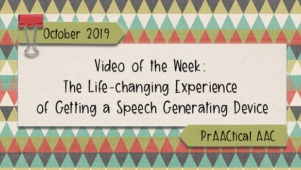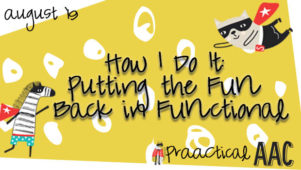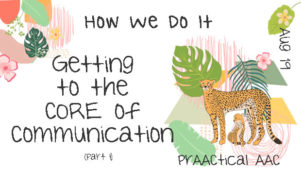How I Do It: Preparing AAC Learners for Their First SGD

One of the greatest privileges of being an AAC SLP is getting to see kids grow and mature when they are given the appropriate communication tools and supports. The other day, I observed a tall, strong young man with significant autism arrive at this therapy session carrying a padded case. Once in the room, he gently laid it on the table, carefully opened it, took out his SGD, and gingerly placed it on the table in front of him. He had gotten his first SGD this summer as a tween, after having used the one in our AAC lab in his therapy sessions for the preceding months.
There were some concerns that when he got his own SGD, he might be a little confused initially since this would be the first time he could actually take the device home. Additionally, some were worried that he might be rough with it and cause it to break. It wasn’t particularly worrisome to us, but these were certainly valid concerns and part of our job is to address concerns like these. It turns out that one strategy helped with both issues: Social narratives.
We frequently developed social narratives for this student in the past to help him better understand expected behavior and changes in routines. It was a perfect fit for this situation, too. Basically, we developed a social narrative using PowerPoint, read the book on the computer a few times at the start of therapy sessions, then sent a copy home for him to read with his parents in the week before his device arrived.
His family and therapists worked together to reinforce these concepts during the first two weeks while the device was new. The result was that he better understood the shift from our device to his and treated his new device with care.
You can download a copy of it here or going to the ‘downloads’ section of our AAC eToolbox. You’ll need to customize it with images of the appropriate SGD and add in names of therapists and family members to individualize the concept, of course.
What strategies do you use to help AAC learners prepare for their first SGD? We’d love to hear about things that have worked for you.
Filed under: PrAACtical Thinking
Tagged With: expected behavior, How I Do It, SGD, social narrative
This post was written by Carole Zangari






3 Comments
This was a great strategy for teaching the gentle handling of a SGD. Thanks for sharing! I’ve worked with a few students who would have greatly benefited from learning this before they received their devices.
Handling of the device isn’t so much an issue at our house. While waiting for the (interminably) long funding process to be completed, we did a LOT of paper-based practice with our daughter to help familiarize her with the screen layout and categories. I made copies of the static core rows from the home page to use with eye gaze responses. We used this “board” with her at home and school, both as aided language input (receptive) and eye gaze response (expressive). The “buttons” were too close together to tell exactly where she was looking but we could get the general gist. The main point was to help her see the value of these high-frequency words and to memorize the location of the buttons. We also made cards of the general categories on the home page and played games to practice choosing what category different words would fall under. Finally, we are now introducing the dynamic subcategories, the ones that help simplify retrieval under the large general categories. Again, card games to the rescue!
Her device is due to be delivered in a week. Hurray!!! I am optimistic that the cognitive training will help her settle in with her device. A benefit of having the device in hand will be the consistent placement of buttons that we could not offer with cards; this will assist with motor automaticity.
We know that mastering any language retrieval system on a SGD is a LOT of work, and that it will take a long time for my daughter to become proficient. But hopefully pre-teaching the static core words and the way this particular software categorizes words in dynamic rows will give her a solid start and a sense of confidence.
Rose-Marie, thanks for taking the time to comment. You discussed another excellent strategy, and one what we frequently use as well. We often continue to use the no tech communication aid as a back-up once the SGD has arrived. Things happen and it is always a good plan to have another way to access language. My fingers are crossed hoping your daughter’s device arrives soon!
I am an SLP and AT Specialist conducting AAC Assessments on students in many districts across our region and I always recommend a training session for the adults that work with and care for the AAC user. We go over how to model using the particular SGD and how to prompt using consistent strategies. The team discusses concerns and we make an implementation plan together. It’s very important to have all the key people including 1-to-1 staff and caregivers in addition to parents come together to get on the same page and share what they know about the AAC user too! I’ve found this type of training helps everyone work as a team to prepare for the implementation of the new SGD.